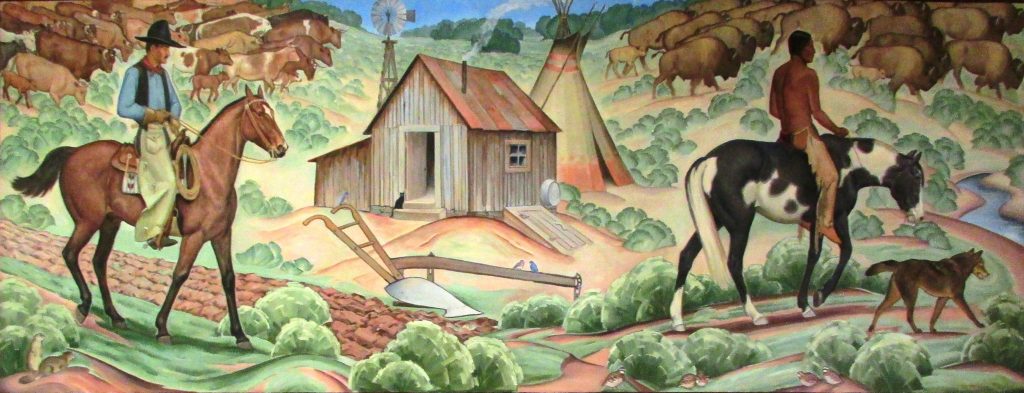Description:
The building was a Treasury Department structure built in 1936 in an Art Deco style. Inside the waiting area above the postmaster’s door is one mural painted by Iia McAfee Turner title The Scene Changes. Remaining in good condition the mural relies on a familiar convention of the passing frontier with the North American wilds, symbolized by the Plains Indian and the unbroken plains, supplanted by Western civilization, represented by pioneers, technological development and agriculture. McAfee Turner explained in an interview ” The cowboy typifies the pioneer. The Indian on his horse heading out of the picture symbolizes the end of the freedom of life which was his heritage. The plow with the turned sod is symbolic of agriculture which followed closely after the cattle men. The homesteader’s cabin, with windmill, in the center of the panel, in indicative of the permanence of this new era as opposed to the tepee of the nomadic Indian.”[1].
The bison, a lone wolf, and a Plains warrior pass off the landscape to the right while cowboy, steers, and a plow transform the landscape from the left. At center, McAfee Turner juxtaposes the wooden homestead with the hide tipi representing the future and past, respectively. Furrowed fields alter the rolling plains only slightly, and the artist was careful to suggest that a terrestrial continuity exists from the nomadic life of the Plains Indians to the agriculture and ranching of the European Americans. McAfee Turner uses uniform flora across the expanse of land, and the prairie dogs and quail stand outside the path of progress as though their existence remains unaffected by the technological and cultural changes taking place in the middle ground. As such, The Scene Changes depicts a wistful image of prairie history but an optimistic view of progress that represented a general history of Cordell and the surrounding region.
The Scene Changes

Sources
- Nicholas A. Calcagno, New deal Murals in Oklahoma (Miami, Oklahoma: Pioneer Printing, Inc., 1976).



Recent Comments